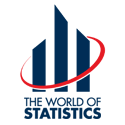1997 Hansen Lecture
Norman M. Bradburn, University of Chicago and NORC
"Statistics in the Information Age"
Journal of Official Statistics, 15(3), pp. 353-366, 1999.
Opening Remarks: Katherine K. Wallman, Office of Management and Budget
Discussants:
TerriAnn Lowenthal, Rothleder-Lowenthal Group
Gail Wilensky, Project Hope.
Abstract: Statistics are a major means of knowing about society. In democratic societies official statistics are available not only to politicians and government officials, but also to interest groups and ordinary citizens. They thus have a special role to play in the process of policy formation and implementation. Until recently, the use of official statistics in policy debates has been limited by the relative difficulty in accessing large data bases by ordinary citizens and interest groups. The advent of the Internet and the World Wide Web, however, has dramatically changed the situation and greatly increased availability of statistics to ordinary citizens. Future technological changes are likely to enhance the amount of data that the public can easily access.
Such a vast change in accessibility of statistical data about society presents many challenges to the federal statistical system. Three of the most pressing challenges concern the relevance, validity, and timeliness of official statistics. Relevance refers to the questions to which the statistics gathered are the answers. How do we decide what data to collect and to make publicly available? As more people can access data more easily, the demand for statistical data and controversy over what data to collect will grow. With limited budgets, the statistical agencies will come under increasing public scrutiny, and decisions about what data to collect will take on added importance. Validity refers to the relation of statistical measures to the concepts they are intended to measure. Do the statistical measures published by the statistical agencies have the meaning that is ascribed to them by the broader user community? How does the statistical system refine measures to account for changes in society that make existing statistics no longer reflect the realities they are supposed to measure? Timeliness refers not only to the gap between the time of data collection and their availability but also to the periodicity of data collection operations and to the revisions in the measures to reflect changes in society that affect validity. Technology may provide means for decreasing the amount of time necessary for data collection and processing, but may not be able to decrease it sufficiently to satisfy an audience that has almost instant access to whatever is available. Increased strains on statistical agency budgets because of broader federal budget cutbacks or the allocation of more resources to disseminating data may force a decease in the periodicity of some statistical series. Technology, however, may have little to contribute toward the decision of agencies to change measures to reflect social changes that underlie the construction of the measures.
While there are great strengths in our present system, a decentralized statistical system such as we have in the United States is not well situated to meet these challenges successfully. There needs to be a forum in which responses to the challenges of wider and easier accessibility to official statistics can be discussed, responses formulated, and then carried out. Perhaps the greatest challenge to the federal statistical system today is how to organize itself to meet the challenges brought about by the technological revolution in data accessibility.






